Auschwitz concentration camp
![]()
Auschwitz is a redirect to this article. For the city in Poland see Oświęcim, for other meanings see Auschwitz (disambiguation).
The Auschwitz concentration camp, also known as KZ Auschwitz, Auschwitz or contemporarily K.L. Auschwitz, was a German camp complex at the time of National Socialism consisting of three successively expanded concentration camps. This camp complex had a dual function as a concentration and extermination camp. It consisted of the concentration camp Auschwitz I (main camp), the extermination camp Birkenau - concentration camp Auschwitz II, the concentration camp Monowitz and about 50 further subcamps. The camp complex was located in the part of Poland annexed by the German Reich. The SS operated the camp complex from 1940 to 1945 on the western edge of the Polish town of Oświęcim (German: Auschwitz).
The people captured throughout Europe were transported by train to the Auschwitz concentration camp. About 90 % were Jews. The countries of origin were Belgium, Germany, France, Greece, Italy, Yugoslavia, Luxembourg, the Netherlands, Austria, Poland, Romania, the Soviet Union, Czechoslovakia and Hungary. The death toll is between 1.1 and 1.5 million.
On 27 January 1945, the Red Army liberated the camp complex. In the post-war period, the name "Auschwitz" has become a symbol of the Holocaust. The anniversary of the liberation of the Auschwitz concentration camp has been the day of remembrance of the victims of National Socialism in Germany since 1996 and internationally since 2005.

Photo of the gatehouse of the Auschwitz-Birkenau concentration camp, taken shortly after the liberation in 1945. Photo by Stanisław Mucha
.webm.jpg)
Play media file Animation on the construction of the Auschwitz concentration camp
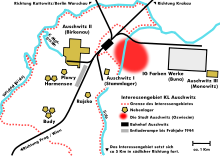
Area of interest of the Auschwitz concentration camp (about 40 square kilometres)
Stock items
Auschwitz I (main camp)
→ Main article: Auschwitz I concentration camp (main camp)
On February 1, 1940, Reichsführer SS Heinrich Himmler instructed the Inspector of Concentration Camps, Richard Glücks, to examine suitable building complexes, prisons and camps in the Old Reich and in the occupied eastern territories to determine whether they could be used as concentration camps. Himmler's directive also mentioned Auschwitz by name. Two investigations by Glücks and the later camp commandant Rudolf Höß came to the conclusion that Auschwitz was suitable for the construction of such a camp. As a result, Himmler ordered the construction of a concentration camp at Auschwitz on 27 April 1940.
The location had been chosen favourably in terms of transport. In the 19th century, Auschwitz had belonged to the Austro-Hungarian Empire and during this time had been connected to the Vienna - Krakow railway line. This railway connection facilitated the rapid deportation of Jews from many areas of Europe to Auschwitz. The sparsely populated surroundings with their river courses as natural obstacles to approach and escape sealed off the facility, making public insights difficult.
The later very large Auschwitz camp complex started with the construction of the main camp, usually called K.L. Auschwitz I. The SS built the main camp in the buildings of a former Polish barracks. It had been built relatively recently and was in good condition. On May 20, 1940, the first concentration camp prisoners arrived at the camp. The main camp later became the administrative centre. In March 1941 Himmler ordered an enlargement of the camp at a nearby village. Block 11 was an in-camp prison with a standing bunker. Thousands of its prisoners were selected and shot at the Black Wall. After escape attempts, the SS sent other prisoners to the bunker as a deterrent, condemning them to starvation.
Auschwitz II (Birkenau extermination camp)
→ Main article: Auschwitz-Birkenau concentration camp
On 1 March 1941, on the occasion of a tour of the main camp, Rudolf Höß received an order from Himmler to build an additional labour camp for an initial 100,000 prisoners. Its capacity was later to be increased to 200,000. In October 1941, construction of the huge second camp began. The village of Brzezinka (German: Birkenau) was completely demolished and replaced by barracks after the population had been resettled. Administratively, it was subordinate to the main camp. The SS had the Auschwitz-Birkenau camp area built as an extermination camp, with the goal of industrialized extermination of people. More than one million people were murdered at this site, mostly Jews, Sinti and Roma from all over Europe. (Note: the SS also carried out industrialised extermination outside the concentration camp system, cf. overview of extermination camps of the Nazi regime).
The "Red House", which stood somewhat apart, was first used for gassings on 20 March 1942. The converted "White House" was used as a gas chamber from mid-1942. From the first half of 1943, the four newly constructed crematoria went into operation, which contained the camp's large gas chambers in the basement.
The individual areas of the 1.7 square kilometre extermination camp were called camp blocks (A, B, C etc.); they were successively the place of detention for different groups of victims. There were wooden barracks on the right side (as seen from the entrance) for women and children under 14 years of age. These included the "family camp Theresienstadt" or the women's camp (Block B I). On the left side were brick barracks for the men. From the summer of 1944, Hungarian National Socialists had taken over power in Budapest, which Eichmann used to increase the deportations of Hungarian Jews (see "Hungary Action"). In addition to Jews, the so-called "Gypsies" also suffered special persecution. The SS set up a special block in the concentration camp for "gypsies" and called it the "Auschwitz Gypsy Camp". Josef Mengele was also active here with experiments on humans.
Auschwitz III (Monowitz labour camp)
→ Main article: Auschwitz III Monowitz concentration camp
In the Auschwitz-Monowitz concentration camp, first called Auschwitz III and later called Monowitz Concentration Camp, concentration camp prisoners were forced to perform forced labor. The camp, a special feature of concentration camps, was built on the initiative and at the expense of I.G. Farben AG together with production facilities beginning in 1941 in the town of Monowice, which also had a rail connection, and was put into operation on October 28, 1942. From November 1943, it was also the main camp, with a commandant also responsible for other subcamps.
Further subcamps and external commandos
→ Main article: List of subcamps of the Auschwitz I concentration camp (main camp)
The Auschwitz concentration camp had about 50 subcamps. Many prisoners died there due to the working and living conditions (→ extermination through labour).
From an administrative point of view, the subcamps were subordinate to the main camp Auschwitz I until the camp complex was reorganised in November 1943. The SS gave them different names, e.g. labour camp, subcamp, external commando, concentration camp, SS labour camp or branch camp.
Some of these satellite camps were located in the wider area, also outside the district, in the "KL Auschwitz area of interest", which was delimited by the rivers Sola and Vistula and covered an area of about 40 square kilometres. They included the Althammer subcamp, the Blechhammer subcamp, the Eintrachthütte subcamp, the Fürstengrube subcamp, the Hindenburg subcamp, the Janinagrube subcamp, the Neu-Dachs SS work camp, and the Krakow-Plaszow work camp. In some of the satellite camps, the prisoners had to work in mines. Subcamps were also attached to the agricultural enterprises of the Auschwitz concentration camp.
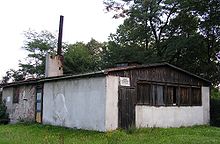
Jawischowitz, one of the approximately 50 subcamps of the Auschwitz concentration camp, remains of a barrack (2006)
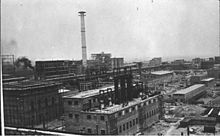
I.G. Farben: Monowitz, 1941
.jpg)
Entrance gate to Auschwitz I concentration camp (main camp) with the inscription "Arbeit macht frei" (2007)

RAF aerial view of Birkenau, rising smoke from the incineration pits (August 1944)
Geographical location
The SS had the main camp (Auschwitz I) built in a former Polish barracks, west of the town of Oświęcim. The region was part of the border area between the German Reich, which had been expanded by annexation in 1939, and the Generalgouvernement.
The Birkenau extermination camp (Auschwitz II) was rebuilt in the autumn of 1941 three kilometres northwest of the Auschwitz I main camp. The entire area covered an area of approximately 40 km² and included an area in the shape of a triangle.
The Monowitz camp area (Auschwitz III) was established by I.G. Farben AG at the end of October 1942. It was located six km east of the main camp, on the grounds of I.G. Farben AG's Buna Works.
The connection to rail transport was to the north in the directions of Warsaw and Wroclaw (further to Berlin). To the south, the rail network led in the directions of Prague, Budapest, Vienna and Bratislava. Two lines led in the eastern direction to Krakow and further to the Ukrainian SSR.
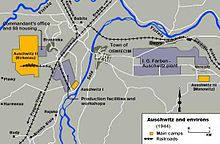
Map of the Auschwitz camp complex with railway connections
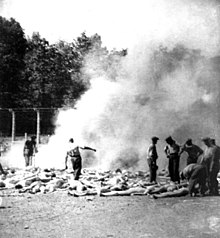
During the "Hungarian Action" in 1944, the capacity of the crematoria in Auschwitz was overloaded, additional cremation pits were built. Photo taken secretly by Alberto Errera (Sonderkommando).
Questions and Answers
Q: What was Auschwitz?
A: Auschwitz was a group of concentration camps run by Nazi Germany during World War II.
Q: How many camps were there at Auschwitz?
A: There were three large camps at Auschwitz, and 3 smaller ones.
Q: Where was the main camp located?
A: The main camp, Auschwitz I, was located in a town in Poland called Oświęcim. ("Auschwitz" is the German name for "Oświęcim.")
Q: Who ran the death and concentration camps in Nazi Germany?
A: The Schutzstaffel (SS), led by Heinrich Himmler, ran the death and concentration camps in Nazi Germany.
Q: What was the purpose of establishing these camps?
A: These camps were established because there were too many Polish prisoners and not enough room in "local" prisons to hold them in.
Q: How many people are estimated to have been sent to Auschwitz between 1940-1945?
A: Historians estimate that between 1940 and 1945, the Nazis sent at least 1.3 million people to Auschwitz.
Q: How many of those people died or were killed at Auschwitz?
A: About 1.1 million of those people died or were killed at Auschwitz.
Search within the encyclopedia